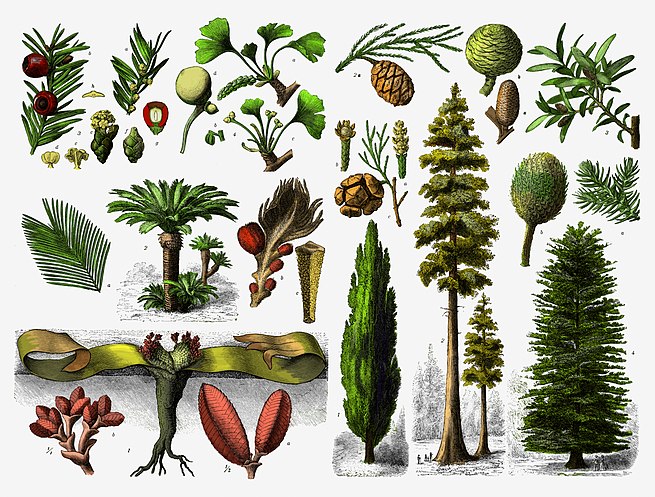
-
Gymnosperm
The gymnosperms, also known as Acrogymnospermae, are a group of seed-producing plants that includes conifers, cycads, Ginkgo, and gnetophytes. The term “gymnosperm” comes from the composite word in Greek: γυμνόσπερμος (γυμνός, gymnos, ‘naked’ and σπέρμα, sperma, ‘seed’), literally meaning “naked seeds”. The name is based on the unenclosed condition of their seeds (called ovules in their unfertilized state). The non-encased condition of their seeds contrasts with the seeds and ovules of flowering plants (angiosperms), which are enclosed within an ovary. Gymnosperm seeds develop either on the surface of scales or leaves, which are often modified to form cones, or solitary as in yew, Torreya, Ginkgo.The gymnosperms and angiosperms together compose the spermatophytes or seed plants. The gymnosperms are divided into six phyla. Organisms that belong to the Cycadophyta, Ginkgophyta, Gnetophyta, and Pinophyta (also known as Coniferophyta) phyla are still in existence while those in the Pteridospermales and Cordaitales phyla are now extinct.By far the largest group of living gymnosperms are the conifers (pines, cypresses, and relatives), followed by cycads, gnetophytes (Gnetum, Ephedra and Welwitschia), and Ginkgo biloba (a single living species).
Some genera have mycorrhiza, fungal associations with roots(Pinus), while in some others (Cycas) small specialised roots called coralloid roots are associated with nitrogen-fixing cyanobacteria.
-
Gymnosperm (noun)
Any plant such as a conifer whose seeds are not enclosed in an ovary.
-
Angiosperm (noun)
Any plant of the clade Angiosperms, characterized by having ovules enclosed in an ovary; a flowering plant.
